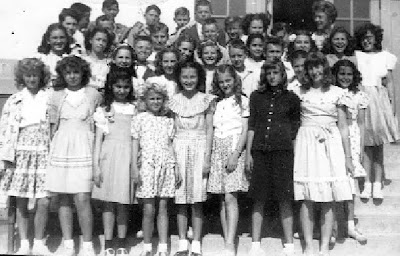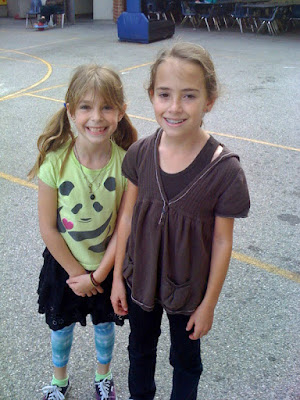
This picture, recently passed on to me by my cousin (the child sitting in the chair), fascinates me. When I saw it, I didn’t recognize ONE thing in it – a real surprise, considering that the girl on the right is my sister and the one in the middle is me. I had nothing in my memory to connect “us” with these children.
Of course after getting used to the picture, I can now “see” us and don’t understand how it was that I couldn’t see it at first glance. But I say to myself that I have no recollection of my sister ever having long hair like she has here. I have no understanding why I would be in bedroom slippers when I am not in my own house, I can’t figure out why my cousin is sitting away from us and not participating in what we were doing (and just what was that?) and I don’t recognize the setting, except that there IS a picture on the right hand side that definitely is my cousin at a younger age.
My cousin Shirlee knows when it was taken, because she said it was when she was recovering from rheumatic fever or some other such sickness that I don’t remember her having. But I’d guess it was taken sometime between 1945 and 1947.
Memory and recognition are sometimes strange things. An example: In 1988 the old girl scout troop I was in for a 10 year period covering grades 5th through high school graduation, arranged for a Girl Scout “meeting” in conjunction with our 35th high school reunion but held the following day. One of the ladies offered to hold a pot luck at her house. I had not attended the school reunion but was anxious to see my old scout friends. When I pulled up to Mary Lee’s house, another car pulled up right behind me. The other driver and I both got out carrying plates of food and obviously were headed to the same place. But I did not recognize her at all. Nor apparently did she recognize me. We stopped at the sidewalk, faced each other with question marks on our faces, and said, “Who are you?” I told her I was Bobby and she told me she was Irene. The minute she identified herself, I SAW her. How could I not have recognized her? She looked exactly the same as she had in 1945! And when we graduated in 1953. And when we’d seen each other at the various other scout reunions we'd had over the years. In a flash, she was changed from the face of a stranger to the face of my friend Irene.
Yet seeing the picture above elicited no such remembrance and I still don’t have a kind of “AHA!” feeling about it, a feeling of familiarity. That made me think of how many memories I have of events, places and people of my childhood that are directly connected to pictures in the baby book my mother kept for me and for the several photo albums I kept throughout my childhood. I SAY I remember my grandma taking me when I was 4 years old from Long Beach to Los Angeles for lunch at Clifton’s and a ride on the Macy’s department store escalator. We went several times; my grandma liked to shop at Macy's. My mom and grandma always referred these trips as “binges.” Even hearing or reading that word conjures up vague memories of those times. I say I remember grandma and me doing this because the picture has familiarity.
I know I have a darn good memory of things past, but I also know that sometimes memories can be partly manufactured. An example is that after I had gone away to college my mother asked me if she could give my Storybook Doll collection (a childhood collection of no particular importance except that I always liked them) to my young cousin Nancy. That was fine with me. Nancy was 11 years younger than I was and I knew she would have fun with them. Many years later Nancy and I were having lunch together, talking about old times, and I mentioned my old Storybook dolls my mom gave her. She had no recollection of what I was talking about and denied ever having such dolls.
Later in thinking about this, it occurred to me that perhaps my mother gave them to my other cousin Karen, just a year younger than Nancy, and somehow in the intervening years my memory “slipped.” This was what my family always called a “right church, wrong pew” moment – some parts right, some parts not exactly right.
However, even with all those memory possibilities, I am still surprised at the picture above – at my sister’s hair (although I’ve wondered if it was near Halloween and we were in costume, her with a wig), at what on earth we were doing (apparently striking some kind of “vamp” poses, wouldn't you say?), and at why I don’t remember my cousin being sick for a long period of time (I was always the one who was considered sick, not Shirley.) I have to tell you that this photo still does not conjure up any recollection whatsoever. I now “see” that these truly are us, but I can hardly believe it so.
And because we are so dorky-looking, I almost wish I didn’t have to.
*NOTE: Click on picture to enlarge it.



















